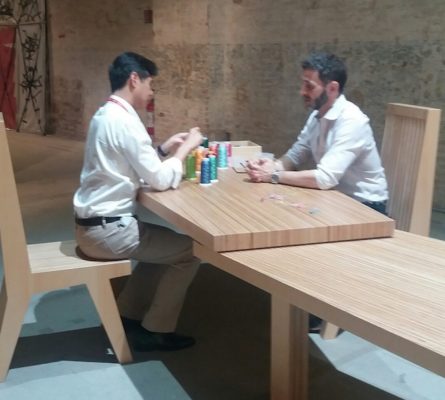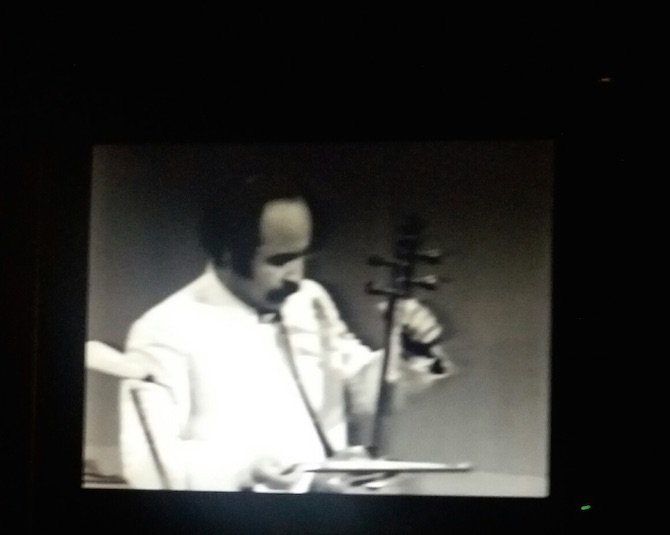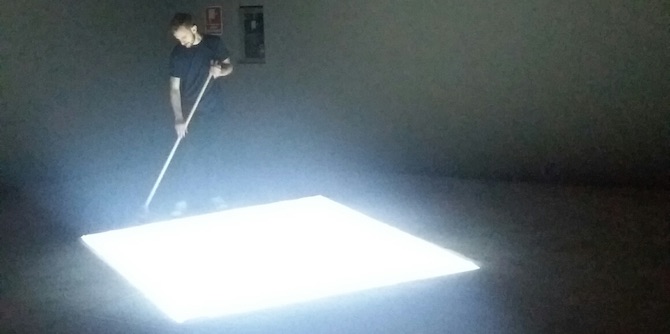Search
To search for an exact match, type the word or phrase you want in quotation marks.
A*DESK has been offering since 2002 contents about criticism and contemporary art. A*DESK has become consolidated thanks to all those who have believed in the project, all those who have followed us, debating, participating and collaborating. Many people have collaborated with A*DESK, and continue to do so. Their efforts, knowledge and belief in the project are what make it grow internationally. At A*DESK we have also generated work for over one hundred professionals in culture, from small collaborations with reviews and classes, to more prolonged and intense collaborations.
At A*DESK we believe in the need for free and universal access to culture and knowledge. We want to carry on being independent, remaining open to more ideas and opinions. If you believe in A*DESK, we need your backing to be able to continue. You can now participate in the project by supporting it. You can choose how much you want to contribute to the project.
You can decide how much you want to bring to the project.

A few weeks ago, while visiting the international exhibition “Viva arte viva” by Christine Macel at the Venice Biennale, I couldn’t resist sending a message to a group of specialists in intellectual property who I greatly admire and with whom I share a good deal of complicity. “Sirs- I said to them – I’m sorry to say it, but 90 per cent of the works on exhibit here, according to the Law of Intellectual Property, are either not works of art or offenders…
I wasn’t exaggerating: at the entrance to the Arsenale is exhibited The mending project, de Lee Miwel. (Taiwan, 1964). An installation made up of a table, two chairs, and bobbins of coloured thread on the walls. The artist (or his assistant) sits at the table during the hours the biennale is open to the public. The visitors to the exhibition take their own bits of clothing that have some rip or loose stitching, and sit at the table while he mends the piece of clothing with one of the coloured threads hanging from the wall. When the operation is over, the piece of clothing with the coloured thread still attached is exhibited on the table on a mountain of clothes. Emotional ties are created between the artist and the public, made material by this thread. This is the idea. And this is the problem: intellectual property protects the expression of ideas, not ideas themselves. The frontier between an idea and the expression of an idea is one of the fundamental limitations of intellectual property in all jurisdictions. This frontier separates what is protectable from what is not. A work, according to the law of intellectual property, must be original and captured in a tangible or intangible support; it has to be a concrete expression of this idea that reflects the singularity of the artist, their individuality and creative genius. But what happens, when it is the idea that’s important and not its expression? Is the colour of thread Miwel chooses for the stitching important? No. Is it important if the mending is the work of Miwel or his assistant? No. Is it important to whom the pieces of clothing that sit on the table belong? Probably not. The law will protect that specific installation, the disposition of trousers and shirts, how the space in particular has been arranged in Le Corderie of the Venice Biennale. But not the idea. Any other artist could recreate this idea if it was done with a different aesthetic result.

A little bit further on there is the work of Kader Attia, a French artist, of Argelian origin. Attia is an artist of great complexity who was already present in the Documenta of 2012. His work gravitates around the subjects of identity, decolonisation, and transsexuality. In Venice, Kader Attia endeavours to reveal the invisible, or inaudible, with an installation in which a corridor full of books, photographs, collages and record covers leads the visitor to a dark room, in which there is an installation with various trays full of grains of semolina. The trays agitate forming perfect geometric forms while the grains react to the sound of the songs that alternate on the screens shown on the walls. It’s a recreation of a scientific experiment by Ernst Chladni, a physicist from the 18th century: the artist has not “created” anything, simply grouped a selection of elements and recreated the experiment of a scientist from three hundred years ago, seeking an emotion in the spectator. All the protectable elements of this installation are works by others. As such, to have the chain of rights well established, the artist ought to have sought permission from all the holders of the rights to the photographs, the record covers, the songs…An organisational nightmare, even if the artist had all the intention of doing things the way the law set out and was predisposed to invest a lot hours in trying to discover who is the holder of the rights to each one of the many elements that make up the installation. There is no exception to the continental law of intellectual property permitting artists to include works by others without requesting permission.
Another artist who also tries to reveal the invisible is Antoni Abad with La Venezia che non si vede, presented in the Catalan pavilion, outwith the Arsenale, within the framework of the eventi collaterali. Antoni Abad has made for the Catalan pavilion an extended sound installation within the public space of Venice, created thanks to the contributions of a collective of blind people and their companions and enriched by all those who wanted to collaborate. The participants download an app and leave a series of geo-located messages that they classify with one of the tags previously agreed by the participants from each expedition. The project also includes a trip aboard a Sanpierotta (a traditional Venetian boat) in which the guide is a blind person, who with their story makes the passengers see things they don’t see, and a tactile comic designed by Max. Of all of this, what the law considers “work” is the software of the app; each of the individual messages (if they are of sufficient “creative standing”); the comic by Max, and the texts of the curators – here there is no problem- and perhaps the stories that the blind people explain in the boats. In this case the artist, Antoni Abad, is not the author of anything, just the idea: who is the author of the project then? All the participants? Perhaps the only answer that judicial order can give, to be able to concede to Antoni Abad the benefits of being “author”, is considering the whole project a “collective work”; a judicial figure contemplated in law for possible instances of multi-authorship. The collective work is a solution that the law has encountered for the cultural industry, designed so that publishing houses and producers can recuperate the investment made in pieces in which more than one author is involved, like encyclopaedias, newspapers, computer programs and other multimedia pieces, but in no case was it invented to protect art projects.
Returning to Le Corderie, where another great installation calls into question the principles of the law of intellectual property. This is One thousand and One Nights, d’Edith Keyndt. More than works of art, this artist makes experiments, staging versions of scientific phenomena from disciplines like meteorology, physics and chemistry. The formalisation of her works varies unpredictably according to the time and place where they are shown: once again the idea versus la expression of the idea. One of the works by this artist is an installation in which a person sweeps up a pile of dust gathered “in situ” to place it within the exact perimeter of a shaft of light that is continually shifting. What is the work of art here? The act of sweeping; protected like a performance? Sweeping is undoubtedly too banal an act to achieve the “creative standing” that the law requires of an original work. The dust raised? Jaume Pitarch already swept up dust in his work dust to dust in 2005. Could Jaume Pitarch claim they had stolen the idea? Obviously not. Intellectual property doesn’t protect the ideas. Ideas don’t belong to anybody.

A final reflection. Faced with these lines, no doubt my jurist colleagues will ask me “but, with these works, what is the intention of the artist? What exactly do they want to protect?” I fear that in the majority of cases none of the artists would endeavour to protect their work to prohibit the copy, distribution, public communication, and transformation by other artists. What the artists who create these works aim for is a just deal with the institutions that produce and exhibition them, to be able to count on the support of their gallerist, if they have one, and in short, to be able to continue creating. This is what intellectual property in its origins aimed to do, to create the fiction of property over works that could be copied to give creators of intangibles an incentive to continue creating. But in reality it doesn’t protect all artists equally: it doesn’t grant those who work with ideas the category of work, or those who incorporate works of third parties in their creations, obliging them to ask for permissions that are often impossible to achieve, leaving them trapped in an immense space of judicial insecurity. The law of intellectual property protects in a clear and diaphanous manner contemporary artists who make works that fit perfectly within the assumed facts that the legislators imagined: books, leaflets, musical compositions, theatrical works, painting, sculpture, photography…works captured in a tangible or intangible support, made by a physical person and totally original, without incorporating works by third parties (or if they do, in possession of the corresponding permission). But in the Venice Biennale, as in most current large contemporary art events, the variety of works presented is much broader.
The law of intellectual property has entered into frenetic legislative activity to bring itself up to date with the transformation from the analogue to the digital world. But exactly a century ago, in 1917, Duchamp placed a urinal in a museum called it “Fountain” and changed contemporary art forever, and the legislator omitted this fact or ignored it. The law of intellectual property continues to be useful for industry, but if it doesn’t change, if it doesn’t question its unalterable principles, if it doesn’t look towards the biennales and contemporary art fairs, it will no longer be useful for artists and very shortly the number of infractions tolerated will be so great that no artist will take it seriously. The law of intellectual property needs to bring itself up to date, if it doesn’t want to exclude contemporary art and it’s already 100 years behind.

"A desk is a dangerous place from which to watch the world" (John Le Carré)